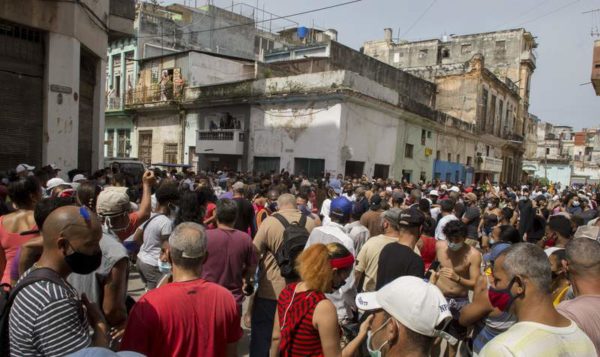Cuba’s Unresolved Crisis 6 Weeks after July 11th
By Armando Chaguaceda

HAVANA TIMES – It’s been six weeks now since protests broke out in a city near Havana, which immediately went viral – thanks to Internet access – in some 62 towns and cities all over the country. Tens of thousands of people, who were overwhelmingly peaceful, marched shouting social and political slogans. The protests stood out for their creativity, diversity and mass turnout. All of this happened under a regime that is Leninist in its political nature, with effective mechanisms to control and mobilize the population.
Like what is happening in many countries today, the Cuban people are suffering under the combined burden of the COVID-19 pandemic, poverty and repression. So-called island exceptionalism, which gave Cubans some social benefits in exchange for the State hijacking their political and civic rights, has ended. Exceptionalism only survives within the nature of a closed regime, the only one of its kind in a mostly democratic region. A regime which – in spite of the recently approved Constitution by popular referendum – has denied its people the right to exercise and demand their rights, before, during and after July 11th.
The Cuban government has repressed civic action, just like the Iranian, Nicaraguan or Belarusian regimes did in the face of popular protests. After the greatest independent mobilization in 62 years, the Cuban government arrested many Cubans (over 700 according to credible sources), including minors. There has been at least one fatality as a result of government repression: independent reports set this figure much higher. Many citizens were beaten by the police and civilians armed with sticks. Many of those arrested have been denied the right to a complete and opportune defense and they have been given summary trials. There is irrefutable evidence proving this. At this point, you just need to look.
Recognizing Cuba’s complex situation does not mean that repression needs to be swept under the carpet. Talking about domestic and foreign factors isn’t repeating the Cuban government’s propaganda. Repeating these things isn’t a waste of time. The crisis of the nationalized economy, which has been made worse by a paralysis of market reforms, has joined the pandemic’s economic impact – which has hit tourism particularly hard, a source of foreign currency – and the effect of US sanctions. Dollarization of the Cuban economy in early 2021 has led to a spike in poverty, inequality and shortages; while the government favored real estate investments over the social budget, building tourist resorts. Doesn’t it seem just a tad too neoliberal for an supposedly progressive government?
Last but not least, the Cuban government has adopted a health policy that bet everything on developing its own vaccine against COVID-19, including the decision to reject the COVAX mechanism. Without paying attention to the rest of the conditions of infrastructure, supplies and personnel that sustain a good public health system. When Cubans on and off the island launched a humanitarian campaign to send medical supplies to Cuba, the government rejected it.
At this time, there is a Molotov cocktail a brewing: the underlying causes of the protests continue, repression has increased people’s fear, and also their rage. The government’s legitimacy does not compare to that Fidel once had. People know that there are many unhappy people, who have a voice and who, in spite of being afraid, took to the street to demand their rights. The streets were theirs, for a few hours. This in itself was very powerful.
Something broke on a psycho-social level that Sunday. I don’t see how that could be reversed so easily, with the vindictive terror of increasing online censorship and trials of protestors still going ahead. Not even with watered down carrots like official visits and donations in the poor neighborhoods that led the protests. By the way, this last point is a message that teaches Cubans that protesting gets the government’s attention and forces them to distribute the same resources they refused before, when they were being patiently demanded and requested via “the established channels”.
Within intellectual circles – understood in the broader sense as the production and diffusion of ideas, symbols and social representations – it seems that three seedlings will continue which we can identify with the chorus of three iconic lines from Cuba’s musical repertoire.
Some seem to take shelter, Silvio Rodriguez-style, in the “El reino del todavia” (the kingdom that still exists), covering up the current situation – prolonged crisis, popular demands, state repression – under the notions of “Revolution”, “Continuity” and “Socialism”, that legitimize the government.
Others let themselves be swept up by the enthusiasm of “Ya viene llegando” (What’s coming, the Willy Chirino song) winds of very confusing changes, overlapping demands from Cubans on the island and the diaspora with politicking statements by influencers and professional politicians in exile. Lots of people believe that the archipelago diverse deserves to be transformed into a civil and plural country, with or without a prewritten script. Where we can build a great country, with everyone and for everyone’s wellbeing.
The US, Europe and Latin America need to push for humanitarian actions, with multi-lateral management, that will bring aid to the Cuban population. Go ahead with the donation of millions of vaccines via the World Health Organization, Red Cross and Caritas; aid that ships and planes from these countries can transport to the island. Accepting that the Cuban Ministry of Health plays a role in the in situ implementation of this aid. Like what happened in Haiti before, where Cuban doctors have worked with USAID officials and supplies.
None of this means denying the authoritarian character of the Cuban regime. Nor does it mean giving up support for the Cuban people’s democratic demands. However, without lives saved there will be nowhere for a future democracy in Cuba.




